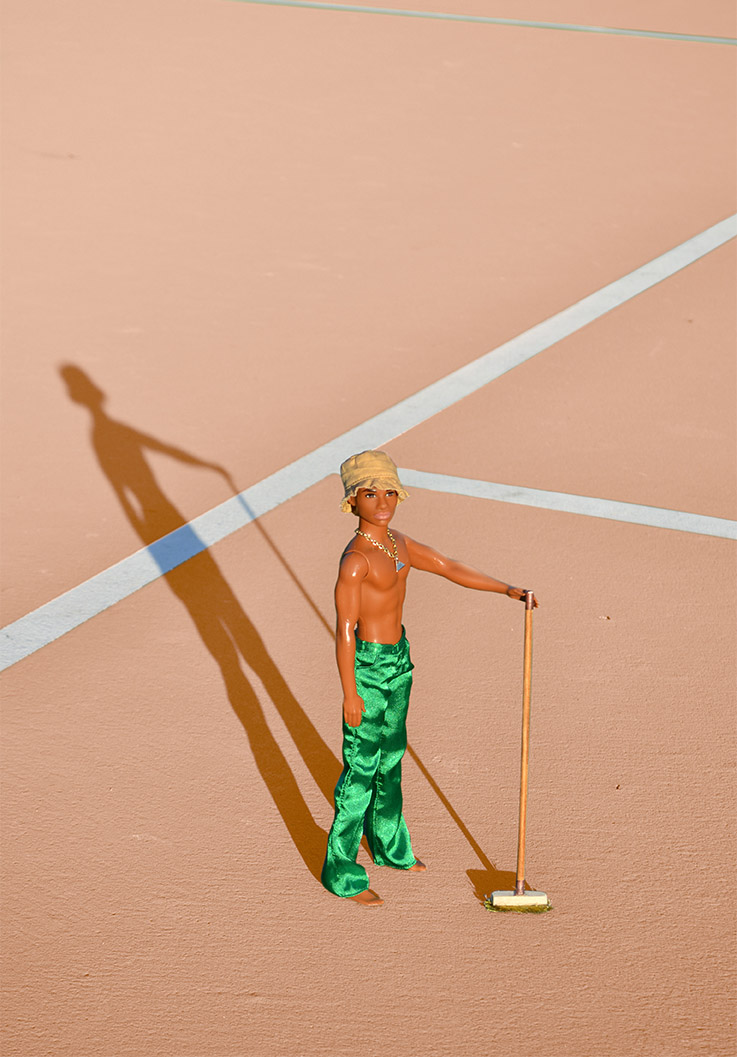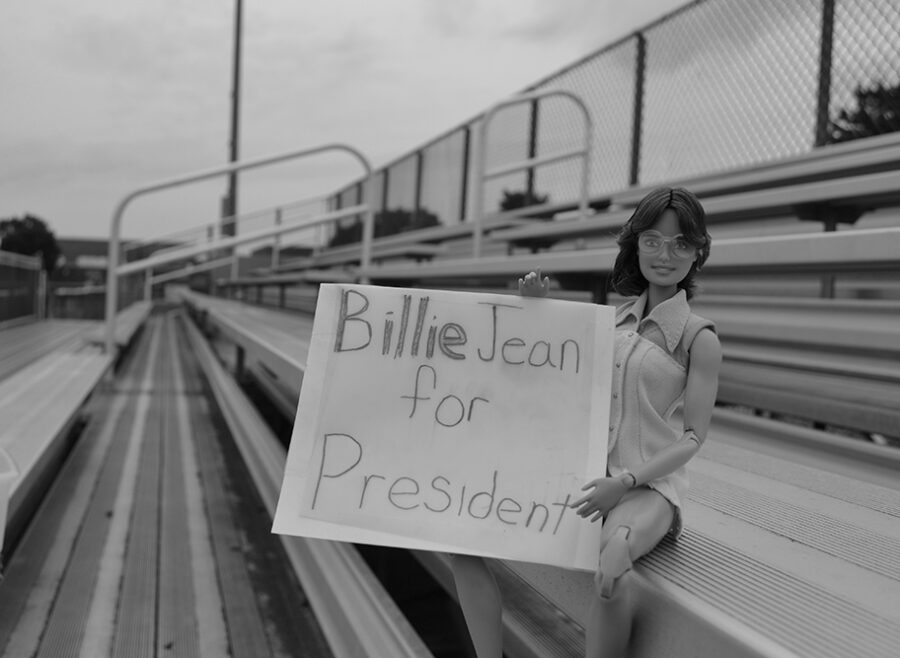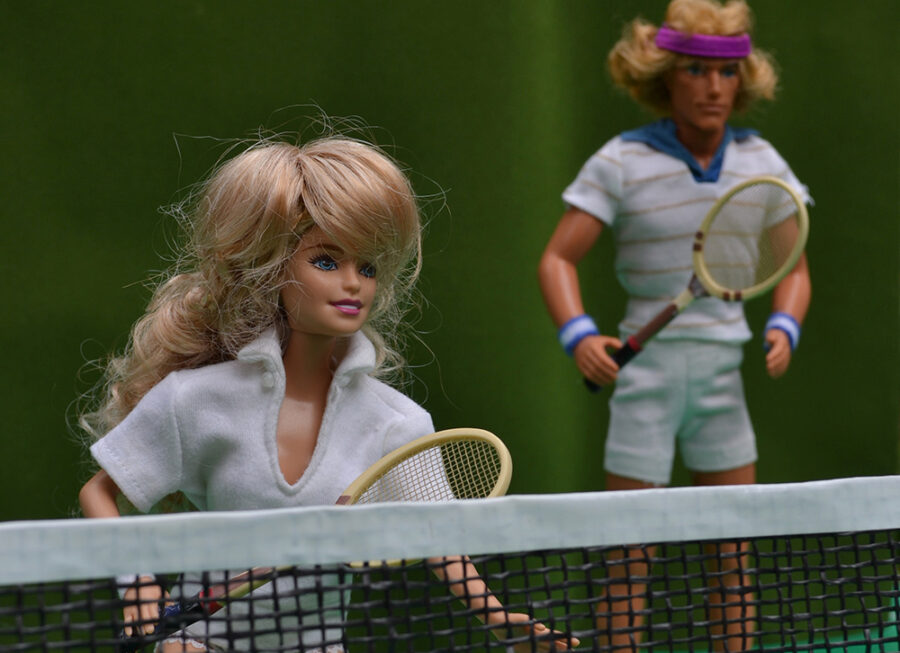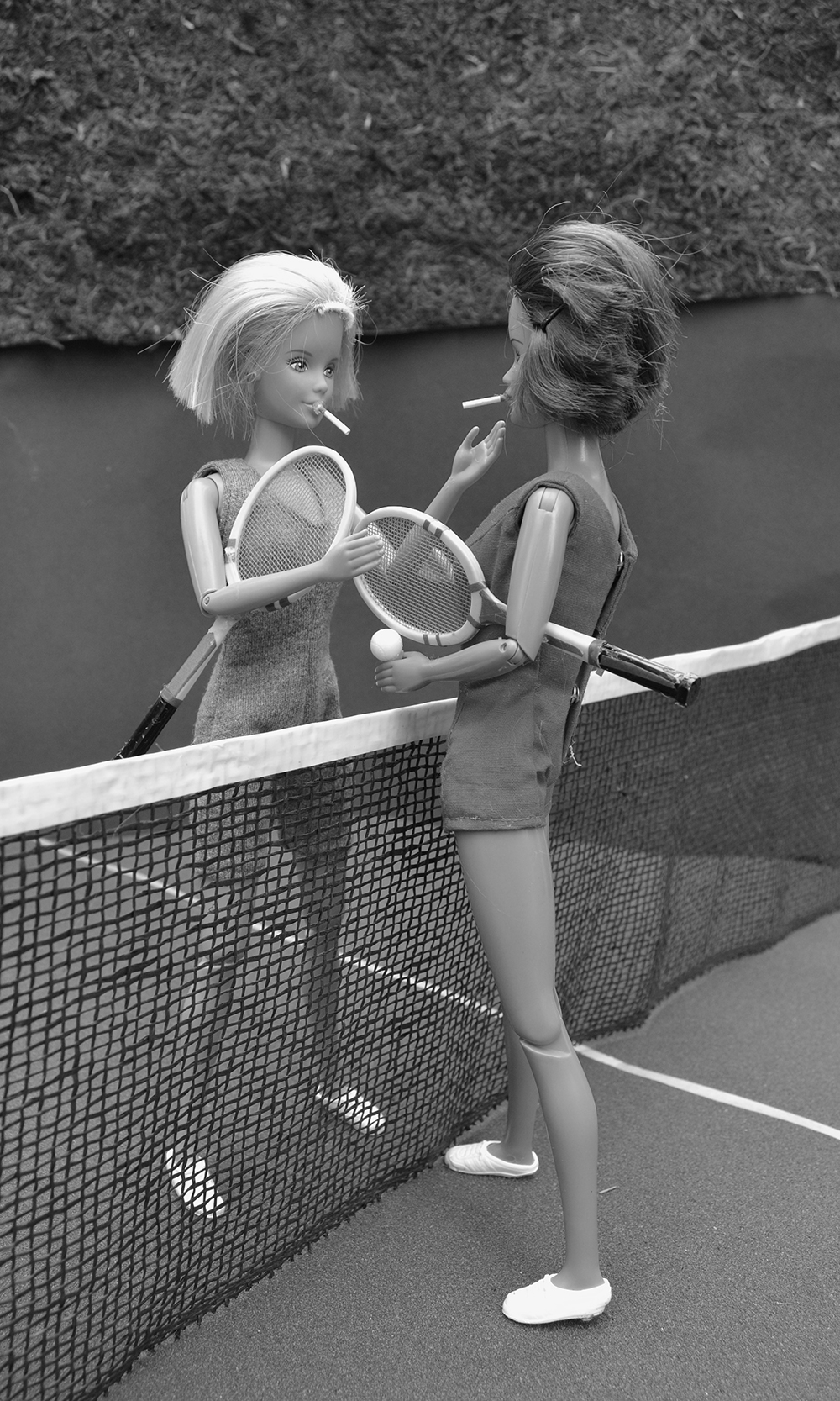By Ben Rothenberg
Photographs by Christine Ferrara
In Which Our Correspondent Hits the Town, Fools Around, and Parties With America's Most Polarizing Doll.
When Trixie Mattel, a contestant on RuPaul’s Drag Race, walked the runway of the reality competition show’s main stage in the season 7 premiere, she wore a bodysuit that emulated the hinges of a naked Barbie doll, to show off her life-in-plastic-it’s-fantastic aesthetic, modeled after the doll’s exaggerated femininity. She accessorized her “nude illusion” look with a pink visor, and held in her right hand the archetypal Barbie accessory: a pink tennis racquet.
Tennis has been a pillar of Barbie’s world since her formative years—the first tennis outfits and accessories for Barbie hit the shelves in 1962, just three years after Barbie debuted in 1959. Tennis has been a Barbie mainstay ever since, with her countless outfits evolving alongside on-court trends from preppy whites to brightly colored synthetic fabrics.
Barbie and tennis have proved to be a perfect match, offering the doll and the humans who play with her a safe space to feel aspirational, consumerist, fashionable, frivolous, fabulous, and nonthreateningly feminine. The harmony between tennis and Barbie is undeniable, but is such a chord the right note for tennis to strike?

***
As I was researching this story and tracking down every Barbie tennis outfit I could find on the internet, one hit that kept popping up in my searches was for Barbie Plays Tennis, an online flash videogame found on both PlayBarbieGames.com and GirlGames.net. An aficionado of just about every tennis videogame there has ever been, I was eager to give it a shot. When the game loads, Barbie is standing barefoot in front of a tennis court in a pink strapless bra, short pink shorts, and bright pink eyeshadow.
The first task is not to serve the ball, but to pick one of 10 hairstyles to click and drag onto Barbie’s head. Eight of the dos feature long, flowy tresses not often seen in any sort of actual tennis movement, but I picked an auburn ponytail that came with a pink visor. The hair reached her navel, but I’m sure Barbie would find a way to get it out of her way when it came time to put the ball in play. The next step was to pick from 10 dresses. Two of them, a purple-and-pink kit and one that was cerulean blue with pink trim, both nicely matched the pink visor I had already chosen. I opted for the purple-and-pink dress and moved onto the next page, ready to put some shoes on her so she could finally take to the court. Instead I was confronted with more clothing options: 10 tops, in case I preferred separates to the one-piece dress. Indeed, there was a yellow-and-blue top-and-skirt combination that caught my eye, but it didn’t match her pink visor whatsoever, so I clicked backward through the menu and found a new hairstyle—a loose strawberry blond ponytail that looked even more impractical for tennis but didn’t clash whatsoever with the new clothing. The yellow shoes were too orange, but the blue shoes matched well, and then there were yellow-and-blue socks clearly made to pull the outfit together harmoniously. Then, lastly, it was time to pick a racquet, and I chose a blue-framed one and dragged it into her open right hand (her left hand had been holding two balls up near her mouth this entire time).
Now that she was dressed and equipped, I was ready to play. I clicked forward to the next step to learn the controls for game play; when I did, I was promptly taken back to the hair menu to start again. Choosing the outfit and dressing Barbie, I realized, was the entire arc of the game; there would be no seeing Barbie actually hit a pixelated ball.
I was initially disappointed, but then realized that I could try out a different hairstyle and start anew. On my second time through the game I picked an orange top with bright blue skirts and knee socks, and realized that when you change the color of the socks, the wristbands automatically change to match them. There was no scoreboard on this game, but I did feel like I did better the second time around. And as disheartening as it was to realize that the outfits were the entire raison d’être of Barbie Plays Tennis, it was by no means the most demeaning Flash tennis game I had ever played; that title remained firmly in the hands of a beach-tennis Flash game that had been popular in the computer lab of my all-boys high school: When your player got a five-point lead against the computer, both players’ tops disappeared.

***
Barbie was like no doll before her. Created by Ruth Handler, Barbie was named after Handler’s daughter and anatomically modeled after the German doll Bild Lilli, who was a sort of pinup totem marketed toward male readers of the racy tabloid Bild. Handler’s breakthrough was that a doll could represent an anatomically adult woman and be played with by girls who would see and imagine their possible adulthoods through the doll, rather than the previous dolls for children which represented babies and other young children that were designed to nurture a young girl’s maternal instincts.
Through Barbie, girls would get to play out a life of career success, romance, and luxury—so long as the girl’s family bought each additional outfit. The bigger Barbie’s wardrobe, Mattel posited, the more expansive a girl’s imagination could be. Even just a few years, collecting Barbie’s complete wardrobe would run up a tab of $225 (about $1,900 in today’s dollars), according to the writer Donovan Bess in 1965, who pointed out that Barbie “likes tennis and any other upper-class sport that demands expensive clothes (the ski-queen outfit costs $3.25).”
Barbie can also happily go downscale, however. M.G. Lord, the author of Forever Barbie, wrote that “Americans often argue that this country has infinite class mobility, which is, of course, hyperbolic—for everyone except Barbie. Barbie can not only ascend the social ladder, she can occupy several classes at once.”
The sociologist Pierre Bourdieu divided sports into “classical” ones practiced by the European bourgeois and “Californian” categories that are more egalitarian and free-spirited. Barbie straddles both spheres, and tennis was able to be packaged for either aesthetic and price point. The cheapest Barbie tennis outfits in recent years, usually featuring bright shades of pink, sell for under $10; the most aspirational tennis outfit, from the “Barbara Millicent Roberts Collection,” now routinely resells for close to $100, including a monogrammed towel and leather racquet cover. In Mattel’s promotional photography for that outfit, in which Barbie in her collared shirt and pleated skirt looks ready to play at a club with any type of whites-only policy, Barbie’s hair is coiffed into the sort of crisp platinum blond helmet of which Callista Gingrich could be proud.
But could Barbie really belong in that world? According to Lord, Barbie’s materialistic modus operandi is irredeemably nouveau riche. “Barbie has the taste of a lottery winner: She piles up all that junk in her dreamhouse,” Lord told me. Not that teaching consumerism was anathema to upper-class moms in the ’90s, Lord believes, but it has to be the right kind. “The American Girl dolls, they came with little books, but they also came with historical objects, and the main thing it was teaching the little girls about was archaism, the value of older things, antiques. It was teaching them what to bid on at Sotheby’s.”
Recently, however, Barbie has been nodding toward history as well, and bringing tennis along with it. While Gloria Steinem recently called Barbie “everything we didn’t want to be and were being told to be,” in the 2018 documentary Tiny Shoulders: Rethinking Barbie, one of Steinem’s contemporaries in the 1970s women’s-lib movement embraced the chance to be Barbiefied.
Billie Jean King admitted she hesitated when approached by Mattel about making her into a Barbie, but was impressed after doing “some homework” on the doll’s history, and was further impressed to hear that her doll would be launched alongside Ella Fitzgerald and Florence Nightingale dolls. “I love Ruth Handler, how she thought about why she did it,” King told me. “She did it for independence, for girls to imagine that they could be anything. So that’s the reason I did it, because of her philosophy.”
Though feminists of King’s generation might consider the notion of a Billie Jean King Barbie oxymoronic, Lord believes that its inclusion reflects Mattel’s reading of the current day, as they always have strived to do.
“I think the tent has gotten bigger, and it’s probably gotten bigger because I don’t think corporations ever do anything that is not in their financial interest,” Lord told me. “Probably mothers remember the historic match with Bobby Riggs—or don’t even remember, because they were not alive. The doll’s identity is very fluid now, and I think when people deride things as being Barbie-like, they’re thinking of the original doll, not necessarily what the thing is today.”
King, who narrowly missed being in the target demographic when Barbie debuted, said she grew up with “dolls in one corner of the bedroom,” while the other corner held “bats, mitts, and then eventually tennis stuff.” Rather than rejecting the fashion component of Barbie, King said she embraces it as a student of history.
“Fashion really reflects where women were, and the lack of freedom we had with our bodies and with sports, how restrictive society was for women through fashion,” King said. “Fashion tells you where people are, how things loosened up over time.”
The outfit commemorated on King’s Barbie is a re-creation of the one she wore when beating Bobby Riggs in the 1973 Battle of the Sexes, designed by legendary tennis couturier Ted Tinling. Though it was initially Tinling’s backup offering, the dress thrilled King: The green-and-blue colorway evoked her unlikely passion for the Ballets Russes, the company directed by Sergei Diaghilev with scenery and costume design by Leon Bakst.
“Bakst was doing the scenery in blue and green at the time, back in the early 1900s,” King told me. “I loved the blue and green, so when I put that one on I said, ‘Yes! I love this!’”
“I wish he were alive to see it,” King said of Tinling and the Barbie dressed in his fashion. “I think he would be thrilled.

***
As I stockpiled every available tennis Barbie this year, the Billie Jean King stood apart from the rest. Not only was it representing a real person, it came with a “Certificate of Authenticity” to show that it was part of the “Barbie Signature Black Label” collection: “This certifies that your Billie Jean King Barbie® Inspiring Women™ Doll was created through the collaborative efforts of designers and artists at Mattel.” Isn’t that how all Barbies are made, I wondered?
(Naomi Osaka was also recently made into a Barbie, but hers was not mass-produced. In a statement, a Mattel spokeswoman said Osaka was “gifted a one-of-a-kind doll made in her likeness, which is the highest honor from the Barbie brand.” Though the first Black Barbie was not made until 1980, there have been many Black Barbies playing tennis since the Williams sisters emerged on the scene.)
Unlike the others, Billie Jean King Barbie’s box was designed to look like a grand stadium, perhaps evoking the Astrodome in 1973. It’s a far more glorious milieu than that of the box beside hers, that of Tennis Coach Barbie, who stands in front of a backdrop of a ball hopper and a couple pink benches.
Tennis Coach Barbie, I realize, can’t model particularly good technique. Though she can spread her legs, her knees cannot bend. Her left arm is rigidly straight; her right elbow is bent at an acute angle. A tennis swing would require an arm to achieve both, but not just one or the other. Her racquet holding is not particularly textbook, either: Her racquet comes with a helpful handle attachment, but she can only hold it so the face is close to parallel to the ground. The bag accessory, however, scores points—the racquet slides in smoothly, and its strap rests nicely in her bent elbow. She looks much more comfortable with a handbag than a forehand. But as Mattel’s online game taught me, the point is for Barbie to be dressed for tennis, not to actually play tennis. I’m reminded of one of King’s catchphrases: “You have to see it to be it.” Well, with Tennis Coach Barbie, at least there’s a visual.
Billie Jean King, in her box, is in much more of an action pose, and actually appears to be holding her Wilson racquet. Unlike the rigid coach, Billie is eminently full of joints: Once I break her free of the plastic bindings with various sharp implements, I find that her knees bend, her elbows bend, her wrists bend; she actually could make something somewhat resembling a tennis stroke, though perhaps she doesn’t have the shoulder mobility that a coach would desire. Her hair is also quite stiff, sprayed to hold the shape of her ’70s shag—and probably replicating it more accurately than on Emma Stone’s head in the movie version. Her round glasses also look impressively accurate, as do her blue Adidas sneakers. There are a few plastic tabs sticking out through the back of her head; I can’t figure out how to pull them out, so instead I push them into her scalp, where they disappear into her hollow head.
Billie Jean King Barbie is also considerably more muscular-looking than the other Barbies. She’s got real biceps, visible calves and quads—again, more accurately personifying the actual Billie Jean King than Stone.
But as I move her more, and bend the knees, I realize that with gain in function comes a significant loss of form. Knees that can bend, it turns out, are pretty darn ugly-looking. Tennis Coach Barbie’s legs didn’t work, really, but they were considerably nicer-looking.
Perhaps because of my online fashion training, I decide to see how Billie Jean King and the Tennis Coach Barbie would look if they swapped outfits. I pull apart the Velcro down the front of Billie Jean King’s dress and am immediately mortified by the sight of a topless Billie Jean King. I just stripped an equal rights icon! It feels…just…wrong, being confronted by Billie’s bare bosoms. I look away as I pull off her undershorts. Side by side, it’s clearer how much bigger Billie is—her arms, her waist, even her breasts are proportionally bigger. It’s difficult putting Tennis Coach Barbie into Billie Jean King Barbie’s dress—I can only do it if I put it on her left arm first, and then carefully work the bent right arm into the hole. The dress is loose and unflattering on her, shapeless and matronly. Billie Jean King Barbie has little trouble, with all her bendiness, sliding into Tennis Coach Barbie’s outfit, but it makes her look much more boxy and broad-shouldered. Not that this is a bad thing for an athlete, of course, but it’s a strange look for a Barbie.
In response to the criticisms over her inhuman proportions, Barbie now comes in a few different shapes and sizes, but the clothing is no longer one-size-fits-all. I’m not sure, as I stare down at Billie Jean King Barbie wearing a top that’s slipping off her shoulders, that it’s a trade-off worth making. One thing that Tennis Coach Barbie definitely has an advantage with is her bag. For all of her trailblazing and authenticity and whatnot, Billie Jean King didn’t get a whole lot of stuff.

Speaking of accessories, a moment to discuss Ken, whose status as an accessory in Barbie’s world is perhaps the brand’s greatest claim to feminism. M.G. Lord, the author with whom I spoke, called Ken “the eunuch priest of a goddess cult.” Ken’s perceived—and anatomical—lack of masculinity is a common refrain, and being Barbie’s frequent mixed-doubles partner (he started playing tennis right alongside Barbie in 1962) didn’t add to his machismo.
“My G.I. Joe was one rough, tough hombre; so rough, in fact, that one day he beat up my eleven-year-old older sister’s Ken doll and absconded with Barbie,” wrote author Steven Hill in the collection of essays Male Lust: Pleasure, Power, and Transformation. “My G.I. Joe carried off Barbie like a prized Helen of Troy. She was [G.I. Joe’s] prize for besting that wimp Ken, who could hardly defend the beautiful Barbie with only his tennis racquet, dressed in those limy green Bermuda shorts.”
In an episode of her web series UNHhhh with fellow RuPaul’s Drag Race contestant Katya Zamolodchikova, Trixie Mattel told the story of her attempt to dress up as Ken for one recent Halloween, excited to try on a playful, obvious twist on her Barbie persona. To transform into Barbie’s mixed-doubles partner, Trixie wore blue contacts, a short blond wig, a white polo shirt, short red shorts, and a blue sweater tied around her neck, and carried a neon green racquet.
But Ken the tennis player, it turns out, is a considerably less iconic look than his plastic paramour. “People weren’t just suspecting, they were certain I was Martina Navratilova,” Mattel lamented. “People were literally coming up to me saying, ‘Love your Martina.’ Like, they weren’t just guessing. And the only people that didn’t think I was Martina Navratilova were like, ‘I love your Ellen.’”
***
Just as Barbie has engaged with tennis, so too have tennis manufacturers engaged with Barbie. In 2005, Head launched a series of pink children’s racquets with Barbie branding for the 2005 holiday season.
“Barbie knows what girls of all ages like and is literally everywhere a girl is,” said Richard Dickson, a Mattel vice president. Greg Mason, the company’s director of sales and marketing, went further. “By aligning Head products with a brand as established and prestigious as Barbie, we will gain instant recognition and credibility among young girls at retail and on the courts,” he said. “With fun, colorful tennis equipment in their hands, young girls will be inclined to play longer and more often.”
In 2019, the classic tennis brand Sergio Tacchini made a pink, blue, and yellow tennis dress for its women’s players, inspired by the Totally Hair Barbie from 1992, to commemorate the doll’s 60th birthday. A Barbie doll wearing the Sergio Tacchini dress was also sold at the 2019 Italian Open.
WTA player Barbora Strycova, who wore the dress and “loved the colors,” said she grew up getting Barbies for Christmas each year, and said she could see the doll’s essence represented on the tour.
“We play in skirts and we try to look nice because there are so many cameras,” she said. “Not really me, but some girls really enjoy putting on a little bit of makeup and doing their hair, and they enjoy the outfits the companies do for them. It’s a little bit similar to Barbie. Barbies are perfect. We are not, but we’re trying to be.”
Ben Rothenberg is co-director, writer, and producer of the World War I documentary The Lafayette Escadrille. His work for the Smithsonian Associates includes his online series Art + History and Jazz in Paris. He was a longtime contributor and editor for Air & Space Smithsonian magazine, with expertise in the Wright brothers and pre-WWI aviation.



